Oak Knoll Books
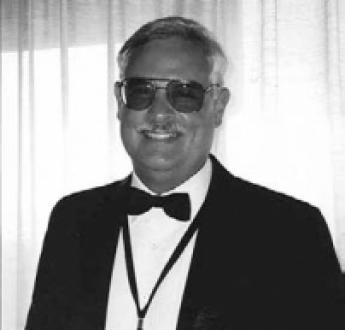
By Bob Fleck
Part 1: A Life-Changing Decision
Thirty years ago I made the life-changing decision that I should try my hand in the world of publishing. Was I breaking new ground in the antiquarian bookselling business? Hardly! Any of you who have read the history of bookselling know that the professions of bookseller and publisher have been intertwined for centuries with large out-of-print booksellers often having equally large publishing programs.
This method of doing business has all but died out today. The following experiment in biography will tell you the story of how our company has tried to resurrect it.
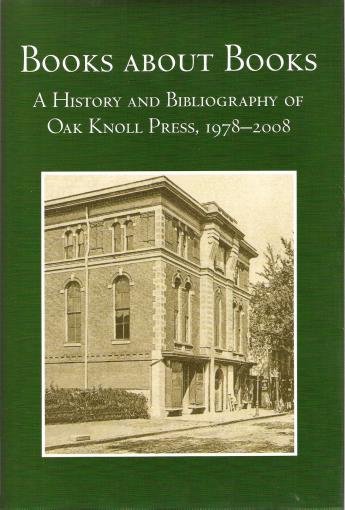
I went to college to study chemical engineering (BChe from University of Delaware, MS Chemical Engineering from University of Virginia) and worked as an engineer for a number of companies from 1971 to 1976. As soon as I had money to spend, I started collecting books and formed large collections of Hemingway, Faulkner, Steinbeck, and books about books. In 1976, I was asked to transfer to Allentown, Pennsylvania. I looked at my job and looked in my heart to determine what I really enjoyed doing. I decided to go with my heart, and on a Monday in early March, I became a rare book seller. I had absolutely no training at the feet of a renowned bookseller, so I made all the usual mistakes of a novice in the field. All I had going for me was my love of books and reading and some hidden skills in business that I had discovered along the way. I made a decision that I was not going to follow the usual path of dealing in the modern literature that I had collected and immediately sold off or traded my personal collection for inventory in the field of books about books. This neglected field of books on the physical production and distribution of books, supplemented with examples of fine printing seemed to be a relatively unbeaten path without much competition. For better or worse, I sank all my limited resources into developing this niche market.
Part 2: The Beginning (1978-1989)
Two years later, to my family’s amazement, I was still in business! My goal had been to make Oak Knoll Books the one-stop shopping place for customers who sought “book about books,” whether it was out-of-print or newly published. Stocking other publishers’ books had great potential for financial disaster, as the 40% discount I received made for a very small profit margin and the inventory had to be turned over quickly. However, goodwill was generated as my customers appreciated the effort we put into keeping them informed of the newest books in their field. This made them think of us for the out-of-print titles they wanted. In those days, there were a few publishers of books about books who concentrated on producing reprints of the classic titles. Specialty dealers like me were experts at knowing what out-of-print titles were in constant demand by our customers and owed it to them to seek out these reprints.
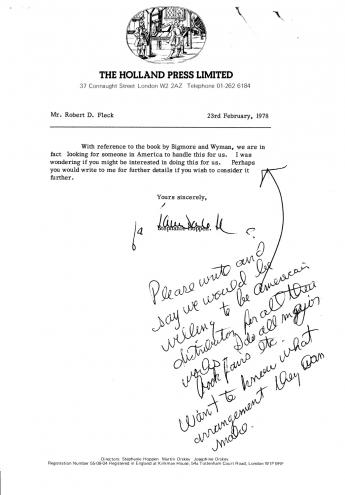
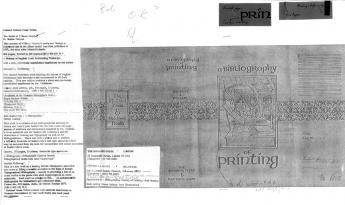
An English firm called the Holland Press had been purchased by new owners and was aggressively reprinting important titles in my field, so I wrote to them for a catalogue. The catalogue arrived and was full of just the kind of books my customers wanted. I had my secretary (my one part-time employee, Karen) write to them in February 1978 inquiring about a number of their upcoming titles. One week later, an answer came back from Stephanie Hoppen (co-owner with Richard Leech), which concluded with an intriguing paragraph indicating that they were looking for someone in America to handle a reprint of the classic bibliography of printing by Bigmore & Wyman. I hand-scribbled a response onto the letter, and a number of letters and phone calls later, I arranged to buy into the print run. For the first time, Oak Knoll appeared on a title page! They also allowed me to buy their other titles at a substantial discount and market them exclusively in America. After a few meetings with them in both London and New Castle, I found out just how jovial this publishing business can be. The English publishing world is filled with long lunches with good cheer and much wine!
Part 3: A 2nd Publication and the Move to New Castle
The second Oak Knoll publication was about as ephemeral as one can get: a 1979 Christmas keepsake printed by John Anderson at the Pickering Press. I had developed a friendship with John, a noted typographer whose small private press books were some of the best contemporary examples of fine printing. Over the years John and I had alternating lunches between Maple Shade, New Jersey, and New Castle, Delaware, and I got to hear some of the classic tales of typography in action. (His best tale was of Beatrice Warde and the animated talk she gave to a group of Philadelphia printers. Beatrice’s talk was so animated that one of her breasts fell out of her dress, and she nonchalantly placed it back with a smile).
I moved my business from Newark to New Castle in December 1979. John and Emily Ballinger moved up from North Carolina and bought into the business, and their down-payment was just enough cash to allow me to buy 414 Delaware Street from Herb Tobin, a legend in New Castle lore. Herb was the last in line of the family butchers and knew every reputable historical fact (and many disreputable) about the city of New Castle. This Victorian storefront had been a butcher’s shop during its entire life before I turned it into a bookshop. The building had great “history” to it, which meant there were cracks and creaks everywhere, and when winter came, the drains froze. There was a typical New Castle basement - low headroom and dirt floors - and the original slaughterhouse behind the house came with my purchase and was quickly converted into a wine storage area. We had a first floor shop, and I rented the second and third floor to the Ballingers as their living quarters. It is a wonder that we all managed to work and store the books that we had in the four rooms on the first floor. The Ballingers had different ideas about running a business than I did, and they departed in 1982 for Williamsburg, Virginia, and the Bookpress, another antiquarian book business.

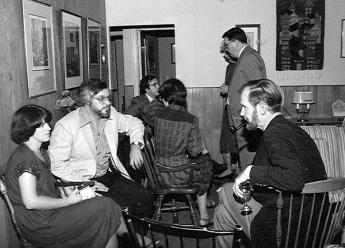
Part 4: New friends, a New house, and a New Employee
The third Oak Knoll publication was also a Christmas keepsake (for 1980) and was an excerpt from Lawrence Block’s The Burglar Who Liked to Quote Kipling, relating a humorous story of what happened to a book thief when caught in Rodenbarr’s bookshop. This pamphlet was printed by hand by Henry Morris of the Bird & Bull Press. Henry and his wife Pearl were new-found friends in 1980, and Millie, my wife, and I had one of our first dates going to Henry and Pearl’s moving party, as they bid farewell to Elm Street in Philadelphia. It was a great party, involving lots of wine and funny speeches that made no sense whatsoever. But it started a relationship that lead to many publications and the establishment of a friendship that continues stronger than ever.
As is typical with all bookselling businesses, Oak Knoll kept running out of room. From our start in 1976 in the second floor bedroom of my Newark home, we had moved to the renovated two car garage and then to New Castle. The first floor of 414 Delaware Street in New Castle proved to be too small as well, so Millie and I moved our home and the business up the street to 212 Delaware Street in 1985. This historic house (the Booth house, named after Delaware Chief Justice James Booth) was built in stages with the first section built in 1713, a wing added in 1795, a lawyer’s office added for the Judge and then his son (both Chief Justices) in about 1830, and two additional sections after that. Four rooms had been added behind the lawyer’s office. We bought it in August 1985 from a DuPont attorney whose wife had used the four side rooms for a daycare business.
Millie and I had looked at this house three years earlier but didn’t have the money to buy it. This time around we successfully convinced the bank to lend us the money to buy the house, with the proviso that we would move the business into the daycare center space and sell 414 Delaware Street. Once in there and functioning, I saw that if we could rent out 414 Delaware Street, we could hold on to both properties. Our friend and banker Gordon Pfeiffer had stood by us since the beginning and he came through once again. Renters were quickly found and the old 414 property stayed in the family. Our youngest son, Rob (keep that name in mind!), had been born in July, so he got to live in two homes in his first month.
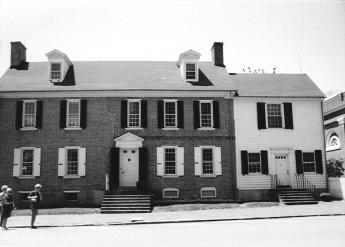
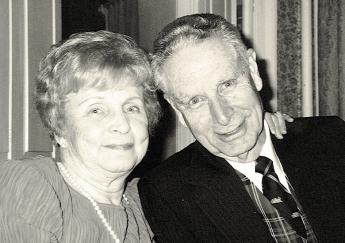
I also had a new employee start in May of 1986, my father. He just retired this year (2008), thus earning credit as the Oak Knoll employee with the longest tenure. My father and mother moved to New Castle from the Chicago area when my father retired as Director of Research for the Griffin Wheel Company, and Dad immediately started working for me at the bookstore. He was our inventory management person and major fixer-upper. His eldest son (me) happens to be hopeless at mechanical things, so his fix-up skills became an important part of his job description. And when the occasional cash flow problem occurred, I knew where a short-term loan could be procured.
Part 5: The Start of the Wakeman Years
Bookselling continued 1985 to 1988 with almost all sales occurring in the antiquarian side of the business and only three publishing titles produced. One of these was Dick Huss’s The Printer’s Composition Matrix, the first new manuscript we published for a larger audience. Many an afternoon was spent in Lancaster visiting this fine old gentleman at his printing company. Dick kept his personal collection of books on printing history there and still set type himself and did personal binding. He eventually sold me many of his books on printing history. We also issued the second book in a series of reprints of important titles relating to printing and binding history (Bib. #12 & 17). In keeping with our theme of adding value to reprints that we published, we asked Paul Koda to write lengthy introductions to each volume, which he did with great skill. Paul was a librarian with a collector’s instinct who often guided us with his astute opinions. As you can see by this chronology, Oak Knoll Press, with its 18 titles, wasn’t exactly exploding on the publishing scene up to 1988.
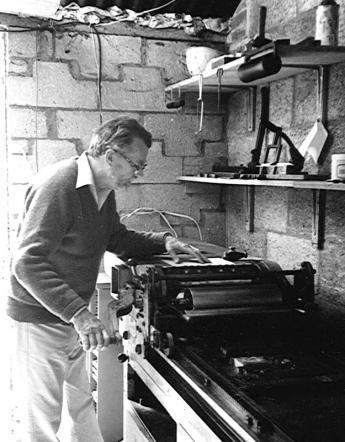
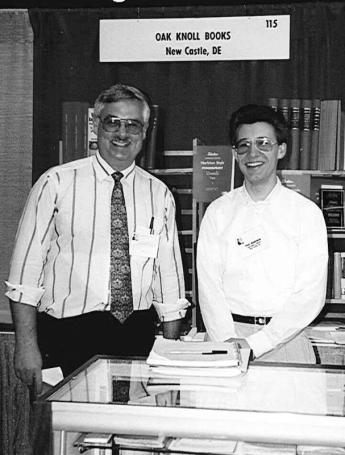
The Wakeman Years (1988-1996)
The fall of 1988 was a decisive time for the business. Our sales were good but needed to be better. I had to reach a decision on how to grow the business. Should I stay in the books about books field with its relatively limited number of expensive books, branch out into other fields which contained more expensive books, or capitalize on our reputation in this specialized field of books about books and increase the publishing program? History shows that I chose the latter. In August of 1977, I had reached out to a very fine private press in Loughborough, England, called the Plough Press. Geoffrey Wakeman had been taught letterpress by Philip Gaskell at The College Press in Glasgow. He was an expert in the field of changing printing and illustration technology and issued privately printed books in this field often illustrated with special leaves demonstrating the techniques he was describing. His wife Frances partnered in the press and operated a rare book business under the name Frances Wakeman, Bookseller. I first wrote to them asking if I could buy some of their limited edition books. This letter led to wonderful visits with the Wakemans, first in Loughborough and then in Oxford.
Their youngest son Paul, following in his father’s and mother’s love of the book business, got a degree at Watford College of Technology with a specialty in publishing in 1986. I got to know this young son and much admired his book knowledge and his personality. After obtaining his degree, Paul worked for Macmillan Publishers in London, but upon his father’s death in 1987, he resigned from Macmillan and the London life and went back to Oxford to help his mother during this troubling time. On my next trip to England, I visited Oxford to discuss the possibility of having Paul come to Delaware to work at Oak Knoll to help move the publishing program forward. We worked out the terms, and both of us were ready to start on an exciting new beginning.
Part 6: Paul Wakeman Dives In!
But not so fast! You may think it would be an easy thing to have someone from England come to work in a small business in New Castle, Delaware, but this was not the case. The trouble began when we applied for a permanent Visa and learned to our dismay that it might take years to get the proper permissions. We were told that we had to run job advertisements in a number of nationwide magazines in the industry in case there was some American with a desire to take a minimum wage job in the little, sleepy town of New Castle working for a neophyte publisher. We ran the ad and got no responses. We then had to wait in the long line of applicants for our case to be heard. Meanwhile, the months were slipping by, and neither one of us was getting what we needed. Calls to Immigration Services were a lesson in anger management.
One of the many better features of living in Delaware, the second smallest state in the Union, is the ability to reach your representative to Congress without the grief experienced in larger states. I decided to use the services of our Congressman, Bill Roth. His office promised to call the Immigration Services and—it must have been a miracle—Paul’s application was moved up in the line and approved. I remember him flying into Philadelphia to start work in August of 1988 just as we were getting ready to move the business up the street. I picked him up from the airport and took him to a grand dinner at my favorite restaurant in Wilmington, Vincente’s, where we plotted the rapid growth of the publishing business and his adjustment to life in America while consuming too much wine. He had brought his cricket equipment with him so he would be in good shape for those long evenings and weekends in New Castle.

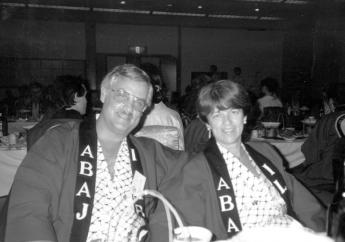
After using his brute strength to help us move the shop, he dived into the publishing business and produced a Christmas keepsake for the end of 1988, three titles in 1989, and five titles in 1990. Two of these were printed by the Bird & Bull Press in limited editions, which allowed Paul and Henry Morris to meet and develop a friendship. Another publication was a book on marbling done in a limited edition with his mother and the Plough Press as a co-publisher. We also published a new edition of Jane Greenfield and Jenny Hille’s Headbands, which continues to sell well to this day. On a side note, I was becoming very active in the Antiquarian Booksellers Association of America (ABAA), first serving on the Board in 1982 and then becoming Chair of their Finance Committee in 1989 and Treasurer in 1990. Millie and I enjoyed the international congresses that the International League of Antiquarian Booksellers (ILAB) conducted and began to attend them in 1990, starting with the Tokyo Congress. This event led to many contacts in publishing that eventually paid dividends, proving yet again that the cross-over between the antiquarian book world and the publishing world is a very healthy relationship.
Part 7: Some Early Publications
Paul got down to work in earnest, and 1991 saw six new Oak Knoll Press publications, including our first joint venture with The British Library (The Doves Bindery by Marianne Tidcombe, #29 in the bibliography). David Way, the Publications Director at The British Library, was a friend of Robert Cross, the owner of St. Paul’s Bibliographies, and quickly became a friend of mine. To this day, we still co-publish many of our titles with The British Library. For about half of these joint publications, David’s staff sees the book through the press, and we buy part of the print run and the North American sales territory (and the opposite for the other half). This way, we can do twice as many books with the small staff that we each have, which is a very efficient way of doing business! David has access to one of the finest image collections in the world with The British Library at his command and also has many excellent readers for the manuscripts that are submitted.
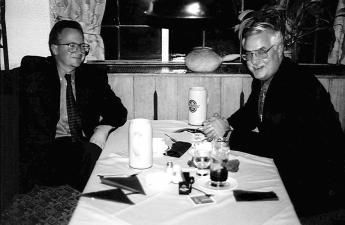

Another special project that year was the re-issue of Percy Muir’s Minding My Own Business (Bib. #32) with a new foreword by Barbara Kaye Muir, Percy’s widow. This wonderful bookselling memoir is one of the best glimpses at bookselling in England during the twentieth century and should be required reading for anyone aspiring to be a bookseller. I travelled to the little village of Blakeney on the west coast of England to meet Barbara (on the smallest train I have ever seen outside an amusement park). She was an author in her own right with many books to her credit, including two more memoirs devoted to bookselling that we published. She hosted a charming lunch full of book talk and good wine, and poured me back on the train for its short ride to Ipswich on the way back to London.
The next landmark in Oak Knoll Press’s history was in 1992 when we finally got the rights to John Carter’s ABC for Book Collectors. This book had been substantially revised by Nicolas Barker, who had managed to keep Carter’s humour while revising and adding new terms. It had grown considerably from its 1952 first edition. If you only have one book about books in your library, this is the one I continue to recommend. I lusted after having this book as part of our publishing program but the rights situation was very complicated. Carter had willed his estate to Eton College with Nicolas Barker as Executor. Somehow, we had to get Eton College to see the need for a new publisher and a new edition. Nicolas used his intimate knowledge of all involved to get the rights back from Harper Collins and Knopf (previous publishers) and award them to Oak Knoll. We reprinted the sixth edition, and it became a best seller for us with a seventh edition appearing in 1995 (co-published with Werner Shaw) and an eighth edition in 2004 (co-published with The British Library), each going through multiple reprints (all carefully documented on the copyright page).

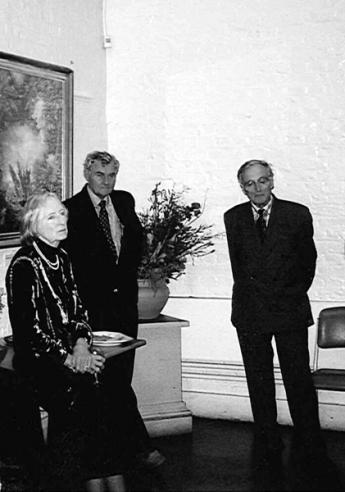
Part 8: New Partnerships Emerge
The end of 1992 also saw the start of a long process of publishing with St. Paul’s Bibliographies, the English company owned by Robert Cross that I had mentioned previously. We had established contact with Robert a number of years before and stocked his titles in our New Books Department. He had started St. Paul’s in 1979 after a distinguished career in the publishing field. Robert knew everybody worth knowing in the English publishing scene and proved quite adept at seeking out dormant rights for important bibliographies from other publishers. He often took those bibliographies and found that special breed of authors known as “bibliographers” and got them to revise an older bibliography or provide a new one. This was quite a feat as the royalty payments for such small print run books often added up to the equivalent of only pennies an hour for all the time spent in doing the bibliography. I believe bibliographers deserve a special place in heaven for their unselfish efforts.
Robert had established the Winchester Bibliographies of Twentieth-Century Writers series with me as co-publisher in 1992 and taken on the publishing of the Publishing Pathways series, which had strong and continuing sales. We saw each other quite frequently on business but always with social times together and developed a mutual respect and friendship. He had been using one of Fred Ruffner’s companies, Omnigraphics, to distribute his titles in America and I suggested to him in early 1993 that the Cross-Fleck relationship had reached the point where Oak Knoll should take on these books as part of a distribution arrangement. The idea was suggested to Ruffner through Cross’s contact at Omnigraphics, Jim Sellgren. The idea was met with favor, and the entire inventory of books was shipped to Oak Knoll under a partial purchase and partial consignment arrangement in October 1993.
We published eight new titles in 1993 and seven in 1994. I found a new way to increase our publishing program—distribution for other organizations. In late 1994, we were asked by the Caxton Club of Chicago to help sell copies of their Club History as part of our publishing list. We worked up a very straightforward contract with our attorney. Oak Knoll would not pay any of the production costs, but would hold inventory of the book and pay the Club 40% of the retail price of the books when we got paid (all discounts to booksellers and distributors came out of our share). Based on the success of this deal, I decided to see if other organizations might be interested. There are many organizations that want to produce manuscripts by their members but do not know how to market a book or sell into the library market. Selling to this market was a specialty of Oak Knoll, so it made perfect sense to offer this service along with advice on retail price, print run, and production costs.
The American Antiquarian Society elected us their distributor in August 1995, the Bibliographical Society of America in May 1996, the John Carter Brown Library also in May 1996, the Library of Congress (selected titles) in June 1998, and the Bibliographical Society of the University of Virginia in January 1999. Since then we have signed up the Manuscript Society, the Typophiles, Catalpa Press, the Bibliographical Society (selected titles), and many other organizations. These distribution deals have increased our publishing list to over 1000 titles of which only about 300 are Oak Knoll Press publications. Booksellers and distributors love this arrangement, as they can deal with one business instead of fifty when fulfilling orders for customers.
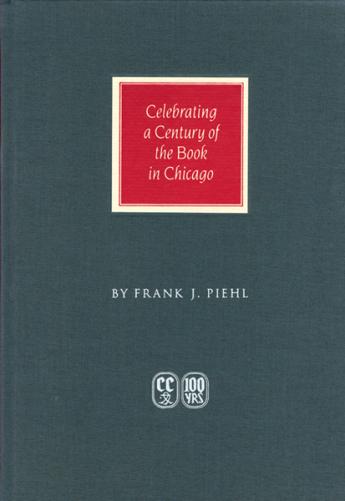
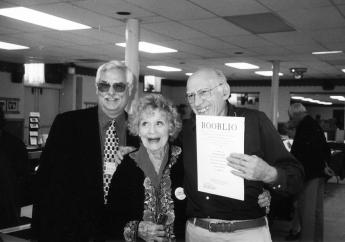
Part 9: The Beginnings of Oak Knoll Fest
Another new idea for promoting Oak Knoll occurred in the fall of 1994 when we sponsored the first Oak Knoll Fest, using the second floor of the New Castle Opera House (more about this later). We thought that a good way to emphasize our specialty area of books about books and fine press printing would be to host an event that combined speeches, a shop sale, and tables of private press books with their actual printers standing behind the table. That first Fest attracted ten private press printers. John Randle, the noted English private press owner of the Whittington Press, gave our key-note address on Saturday evening. We have held a Fest every year since and now attract an average of 40 private presses each year to this two-day event. Hundreds of presses have participated over the Fest’s fourteen-year history. The Fests have provided an excellent venue for customers to view our publishing titles and for Oak Knoll to solicit new publishing manuscripts. The Fine Press Book Association was founded by printers sitting in my living room during our Fest and has become the premier organization of private press owners.
Quickly jumping ahead to 2000, I must show you a picture from our Oak Knoll Fest VII in which Gloria Stuart of Titanic film fame came to New Castle. I’m sure that many a publicist would have died for this opportunity. Gloria Stuart had won an Oscar for her role in the 1997 movie Titanic, but not many of her movie fans knew her as a letterpress printer. She came to New Castle this year and “held court” in such a sweet and gentle manner that she captivated the hearts of all who met her. Our publishing sales went up during that Fest!
We published the seventh edition of ABC and Oak Knoll’s first reprint of Gaskell’s New Introduction to Bibliography in 1995, which completed our trilogy of the three most important bibliographical manuals, which also included McKerrow’s Introduction to Bibliography for Literary Students and Bowers’ Principles of Bibliographical Description.
However, there were the beginnings of troubled waters in late 1995. An unfortunate marriage to an American girl had made Paul’s life in America very difficult, so he took a leave of absence and travelled home, and in early 1996, he announced that he had decided to resign and return permanently to England. His resignation left us with a big void to fill. We interviewed many people in hopes of finding just the right person who could fit into our small publishing/antiquarian business (and do the work for as small a salary as possible!). I hired a young man who met these criteria, but he immediately proved the old adage of you get what you pay for. He was a disaster. Meanwhile, Paul had already returned to England. I then interviewed and hired John von Hoelle, one of the great decisions I have made in my life.
Part 10: Under the Good Ship von Hoelle (1996-2006)
And thus the interesting ten-year saga of the John von Hoelle days began. John had been in the publishing business for many years and was one-fourth owner of Dyne-American Publishers, a much bigger publishing company than Oak Knoll. In those days of wild publishing acquisitions, his imprint had been bought out by ABC Publishing, a larger company. He was also a retired military officer, although he never was that comfortable talking about that early phase of his life. All I know is that he attended the annual meeting of the Association of Former Intelligence Officers in Washington each year and was busy writing a definitive bibliography on non-fiction Cold War espionage literature. John was a book collector with a collection of over 3,700 espionage novels. He decorated his office with photos of himself and friends in various third-world countries in appropriate costume. John had authored 14 books and had a special interest in early language (he could read and write ancient cuneiform and Egyptian hieroglyphics). I could never break him of the habit of calling me “sir.” I always felt a little funny being called “sir” by a man five years older than I am, especially when I was in my usual summer dress of tennis shorts (just in case someone called for a game, of course!).
John had a wealth of knowledge about the book industry although he had never really been in our type of business. He had certainly not experienced print runs of 500 copies before, as most of the titles he published in his prior business often had several zeros added to that figure. John brought experience, calmness, and the uncanny ability to solve problems. I knew that if I had a problem that needed fixing, John would fix it. He relied on me for the financial analysis and the selection of manuscripts; I relied on him for everything else (including the embellishment of a story when needed). He was the perfect representative for our company when doing trade shows or in contract negotiations with authors and vendors. He also designed most of the book layouts and dust jackets of our books. He had a ready smile and a pleasant personality, and he actually wore a coat and tie.

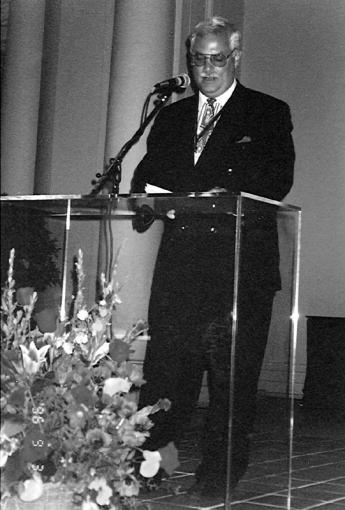
John quickly made his impact felt and 1996 saw us publish 14 titles, which was the largest number we had done in a single year. One of his special feats that year was to help get the final permission to reprint the Pforzheimer catalogue (77), a legendary bibliography that had never been reprinted. We waited forever to get the final signature on the deal because the decision maker, Ross Perot, was too busy running for President to get around to something as mundane as signing one of our contracts.
The other major event that happened in 1996 was my election as President of the Antiquarian Booksellers Association of America (ABAA). It also was the year that the Americans hosted the Congress of the International League of Antiquarian Booksellers in Los Angeles and San Francisco (trade show), so I was a very busy person. The ABAA represents one of the 20 countries that make up the International League of Antiquarian Booksellers (ILAB). My biggest goal was to use the new tool of the internet to help spotlight these two organizations, and sometimes I was probably overbearing on the subject (my French colleagues called me Mr. Internet with perhaps just a bit of sarcasm in their voices). But it also allowed me to do a great deal of foreign travel and form friendships and business relationships with people all over the world.
Part 11: An International Presence
John made sure we got more involved with international trade shows. The British Library’s presence at the London Book Fair in the spring of each year gave us the opportunity to travel there to be part of the excitement and even borrow a table and chair on occasion to meet with one of our authors. John was a fixture at this spring event and always managed to visit family in Wales during this time. David Way also helped guide us through the intricacies of the Frankfurt International Book Fair where Oak Knoll had a booth. Every publisher should exhibit at this Fair at least once, as it is an event that cannot be forgotten.

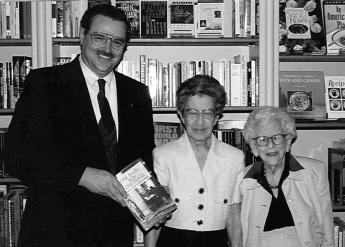
Back in the US, we published the first in a series of titles written by the New York antiquarian booksellers Leona Rostenberg and Madeleine Stern (Bib. #65) in which they reminiscence about their lengthy experience buying and selling rare books. They wrote with charm and painted vivid portraits of many of the famous collectors and dealers of their day. I had known them for a long time and had even reprinted a series of their catalogues as one of our first publications (Bib. #4). They had proposed me for membership in the ABAA in 1978. Over the years we published five of their titles including New Worlds in Old Books. This excellent book was distributed as a gift by Brigham Young University to all members of the Association of College & Research Libraries (ACRL) in tribute to these two fine booksellers. Near the end of their long and productive lives, they submitted a manuscript to us that I felt needed additional work. I called them and talked over my thoughts as gently as I could but my suggested changes were not well received. Much to my regret, they did not talk to me again before they died.
On a happier note, I want to give an example of how the antiquarian business helped the publishing business. As I was President of the ABAA in 1997, I flew to the President’s Meeting in Sydney, Australia with Millie. This was my first trip to Australia, and it was a beautiful experience much enhanced by the warm nature of the Australians. I had gotten to know a number of the other Presidents at the various congresses that Millie and I had attended. The leader of the Japanese book market was Mitsuo Nitta, whose father had started Yushodo, a bookselling-publishing firm in Japan in 1932. Mitsuo is a very special person with great people skills and an aggressive business drive. He has taken his company to new heights while still taking part in many ILAB meetings. He is so highly thought of by the ILAB that he was one of the few booksellers ever named as a Member of Honour of the League. I had previously discussed with Mitsuo the possibility of Yushodo distributing Oak Knoll Press books into the Japanese market, and he invited me to Japan after the Sydney meeting to meet with his various company executives to discuss the proposal. Millie flew back to the States, while I flew to Japan and booked into a small hotel next to his business. I then spent the next three days meeting the various department heads and gaining an understanding of how business methods differed in Japan from America. Richard Carpenter, their English language translator, was assigned to look after me and proved to be a real God-send as he took a liking to me and helped guide me through the intricacies of Japanese business protocol.
Three days of interacting with each department head led to a final dinner in which I was formally told that Yushodo would distribute our titles. This formal acceptance was accompanied by a rather large order of books!

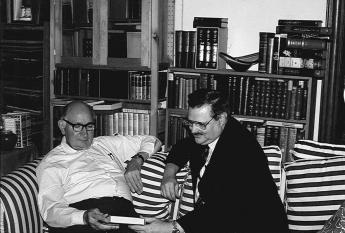
Part 12: Marketing Experiments
Another example of this synergy between the publishing and antiquarian businesses was brought about by an interesting request for bookbinding titles that we received from Marianne Tidcombe, noted English author (though American-born). Marianne told me that she was working on a project to honor Bernard Middleton, the pre-imminent English bookbinder. Important bookbinders around the world would be asked to contribute a gold-tooled binding on a copy of Middleton’s memoirs that had been printed by hand by Henry Morris at his Bird & Bull Press. Twenty-five binders would be chosen and they would be paid for their work when (or if) the collection of bindings would be sold. I was asked to help find the binders, plan an Oak Knoll Press title describing this project which would be accompanied by full color plates of the bindings produced, and then sell the collection as a whole if possible, or piecemeal if it could not be sold as a collection. What a combination of antiquarian, new book, and publishing goals!
The letters to binders were sent out and 25 were chosen to participate. Each binder was asked to price their book and then produce it on schedule. The bindings were eventually mailed to London and assembled in Bernard’s living room. I flew to England to view this unbelievable collection of bindings with Marianne and Bernard. I’ll never forget the magic of walking into that room (I seem to remember candles burning in the background) and feeling the impact of seeing them as a group. We photographed them and produced a book entitled Twenty-Five Gold-Tooled Bookbindings, an International Tribute to Bernard C. Middleton’s Recollections (Bib. #78). The book was produced in a limited edition of 250 hardbound copies, 400 paperback copies, and a number of copies in sheets. The books themselves traveled as an exhibition from The British Library to Rochester, New York (Cary Collection at RIT, home of Bernard’s personal collection of books on bookbinding), and then on to the San Francisco Public Library. It was with great pleasure that I announced that I had found a private collector who was as impressed with this collection as I had been and bought it as a whole, thus preserving it intact.
We also experimented with finding ways to get a selection of our titles into the new bookstore market. We signed an agreement with the Lyons Press of New York in 1997 to act as our distributor for our popular titles (Carter’s ABC for Book Collectors was the star in the line). This company produced an interesting collection of books of their own and distributed a few, selected small publishers. Nick Lyons proved to be a real bookman and gentleman of the old school of publishing with great personal interest in fly-fishing and the production of limited edition books in that field. We increased the print runs of the titles that we gave to them in hopes that they would sell well. The Carter sold extremely well and others sold moderately well. Eventually we discovered that we were mostly just circulating money without much profit coming back to us. The large jobbers tended to order large numbers of copies of books in the hopes of selling them and then sent them all back to Lyons if they didn’t sell. The jobbers demanded large discounts, returned damaged books and didn’t need to worry about their order size since they weren’t paying for the books to begin with. We ended our relationship with the Lyons Press in April of 2000 and put the other distributors on a “proforma” basis and elected to do what we do best—market and sell directly to the end customer.
Part 13: A Visit with Ruari McLean
Another important stepping stone in our history occurred in 1997. The long saga of St. Paul’s Bibliographies reached the end of one era and the beginning of another as Robert Cross decided to retire and sold me his company. I was especially interested in the rights to bibliographies that he had tied up via his contracts and his large stock of unsold inventory. We sold a large portion of the Publishing Pathways inventory to The British Library and gave them UK sales rights for these and future projects, and I had a series of special sales to convert inventory into cash. Robert agreed to continue on in the role of a consultant, helping us find new titles and keeping old author friends in our camp. We had a splendid event in honor of Robert at Stationers’ Hall in London, where I felt a bit overwhelmed with the history of the grand building.
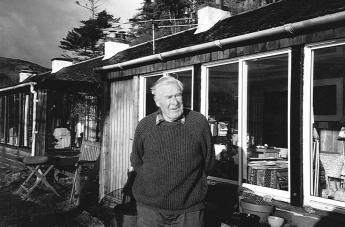
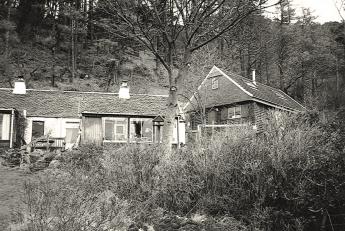
During this trip to England, I traveled to the wilds of Scotland to visit Ruari McLean (1917–2006) as I heard that he had some books for sale and that he had written his autobiography. Ruari lived on the Isle of Mull, which is a rugged island off the west coast of Scotland, so it was quite an adventure to get to him. He had retired from his life in the book production business and was spending his time writing books about various subjects, while still doing some typography projects. He lived by himself (his wife had passed away) in a desolate location on the coast overlooking the sea. Getting to the Isle of Mull required taking a train to Glasgow and catching another much smaller train to the coast town of Oban, where a 45-minute ferry ride got you to Mull. Getting to Glasgow from London was easy enough; however, Ruari had not looked at the train schedule closely enough for my Thursday trip to Oban. Trains don’t run to Oban on Thursdays! So back to the hotel I went and became a tourist in Glasgow for a day.
Friday proved more successful, and I found the small train and positioned myself at the window in preparation for a scenic morning trip through the countryside. Just before leaving, a young burly Scotsman staggered into my car bringing a large bag filled with cans of beer. He had obviously been enjoying the highlights of Glasgow and was now quite well prepared for his journey back to Oban. Much to the amusement of the other passengers on the train, my car-mate started singing old Scottish songs at the top of his voice with only brief pauses to refresh himself from the slowly diminishing supply of beer that he had brought along. Song after song was sung with no sign of slowing. Finally, the conductor came through the car, and I thought my concert was surely going to be ended. “Hi Jamie,” says the conductor, “I see that you have been having fun.” With that the conductor joined him in a song, and then left for the next car. Our concert continued until the beers were gone and sleep overtook my musical friend.
The ferry to Mull from Oban had spectacular views, and Ruari was there at the ferry dock waiting in his car to drive me to his home. We looked at books he had for sale all afternoon, though none turned out to be ones that I wanted. He had already either sold or given away most of his better books. However, he still had a number of manuscripts for books that he had written that were of interest to our publishing program. He cooked a meal for me that evening preceded with and ended by a selection of single malt scotches that I could not refuse out of politeness. The next day I have a hazy recollection of seeing the island of Iona before being put back on the ferry for my long trip back to London. I met him once more when Millie and I and our youngest son Rob went to Scotland for a two-week traveling holiday in 1999. We stayed at Traquair House, the oldest Scottish castle, for a few days, and Ruari drove down to have lunch with us. He was pressing me to publish his war memoirs, but I had to turn him down. Oak Knoll Press co-published How Typography Happens (Bib. #132) with The British Library in 2000 and co-published Ruari’s autobiography True to Type (Bib. #147) with Werner Shaw at the end of 2000.


Part 14: Moving again!
A traumatic change in our lives occurred in 1998, when we moved the business one block up the street to the third floor of the massive building called the New Castle Opera House. We had moved from Newark to 414 Delaware Street in New Castle in 1979, up the street to 212 Delaware, down the street to a renovated 414 Delaware, and now we had run out of room again. We had a three-story Victorian building with a finished basement full of new and rare books and had to get them all to the third floor of the Opera House at 310 Delaware Street.
I had walked past this huge Opera House every day while walking to work. The building had been built by the Masons in 1879 and was typical of many such buildings that have survived to this day. The Masons would create an opera house with high ceilings and a stage on the second floor, meeting space on the third floor, and shops on the first floor that were leased to pay for the building. Each floor contained about 5000 square feet of usable space. Annie Oakley and other famous nineteenth- and twentieth-century actors and performers had danced, sung, and acted on the still-present, well-preserved stage. The first floor had seen a number of businesses come and go during the period I had my business in town including grocery stores, antique stores, and restaurants. There was a cooperative antique mall and tea room on the second floor. However, there was no elevator in the building and the very high ceilings (22 feet on second floor and 11 feet on the third floor) made the third floor a very difficult space to rent. The property owner was a very nice fellow who owned a large computer business in Pennsylvania and had bought the building as an investment property. He had originally worked as a stock boy in the grocery/convenience store that had been on the first floor, so he had fond memories of New Castle. He had spent some serious money preserving the building but it still lacked the essential elevator, modern air conditioning, and heating for the third floor.
I approached the owner and suggested that I would be willing to lease the third floor if he would put in an elevator and modernize the space. The third floor space was empty at that point and wasn’t earning the owner a dime. We worked out the details over the next number of months and signed a basic five-year lease with renewal options in the spring of 1998 with a move-in date of August, as that is when the elevator was to be completed. Hiring Office Movers, Inc., turned out to be a good idea, as the elevator wasn’t finished for another month after our move in and wouldn’t have been nearly as efficient as the moving van/huge crane/and men hanging out the third floor window scheme that they used. The move was disruptive to business, as might be imagined, as all the books had to be put away again in the new space.
The problem of owning an empty 414 Delaware Street proved not to be a problem at all, but a sales opportunity. While teaching at the Rare Book School in Colorado Springs in 1997, I had announced my intention to move my business in New Castle and thus could offer a ready made bookstore all set for a new owner. And the new owner would get the mentoring of an established business right up the street! This appealed to James Goode, one of the students, who bought the building and set up his book business specializing in the sale of rare books on architecture. James fit right into the social life of New Castle, but was more a scholarly author, researcher, and aficionado of the rose than a bookseller and moved back to Washington, DC, three years later, after selling the building to someone who made it into the Velocipede Museum it is today. The money I got from the sale was used to buy a nice beach-front property that Millie and I continue to enjoy.
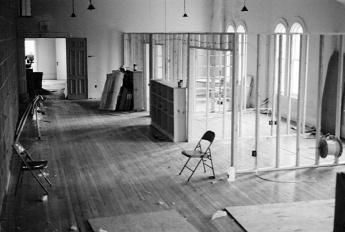

Part 15: Our Greek Friend
John cranked up the publishing program to 17 titles in 1998 and 23 in 1999. We were especially happy to publish Jane Greenfield’s ABC of Bookbinding (Bib. #84) as it fit in well with our other ABC book. Jane’s Headbands (Bib. #26) had appeared in a second edition with us in 1990 and still sells well today. Jane has recently passed away and will be missed by all.
We published Anthony Rota’s Apart from the Text in 1999 (Bib. #105). Anthony (and his wife Jean) and I went back a long way in the book business starting with the day he helped me purchase the remaining inventory of Deval and Muir. He was a Past President of the Antiquarian Booksellers Association (England) and was on the Committee and eventually President of ILAB. He often counseled me on the politics of this group and mentored me in every way he could. A dinner with Jean and Anthony (don’t dare call him Tony) was always full of great food, great wine, and charming talk. He tried to keep me from being too aggressive in my plans for carrying forward my ILAB agenda and sometimes I listened and acted in accord, and sometimes I didn’t. None of this affected our good feelings and trust for one another. We also published his autobiographical Books in the Blood (Bib. #179) in 2002, which is an excellent read.
The 26 titles published in 2000 was our new record for number of books published in a year, but what made it a special year was the publication of The Great Libraries: From Antiquity to the Renaissance by Konstantinos Staikos. Kostas Staikos is a well-known Greek architect and historian with an abiding love for the history of libraries. In his spare time, he had formed a remarkable private collection of books tracking the development of Greek printing throughout the world, rescued a Greek letterpress printing shop, and become part owner of a large, modern printing plant in Greece. To call him a true Renaissance man is probably an understatement.
One day Andy Armacost, our Director of Antiquarian Sales (1995-2004) fielded an incoming call from Mr. Staikos, who asked if we would be interested in publishing an English language history of the library that he had written and published in Greek. Andy turned the call over to John von Hoelle who listened with respect, but also with the reserve that must be used for all authors calling out of the blue with potential major publishing projects. We had no idea why this man had chosen to ask Oak Knoll Press to publish his book until a call later in the week by Nick Basbanes about another matter shed some light. Nick had visited Staikos in Greece to interviewe him for a book about collectors. His mention of Oak Knoll Press must have resonated with Kostas and resulted in that phone call.
Kostas’s book has become one of our all-time best sellers, which was surprising to us as the price of $125 was higher than most of our titles. It was so well produced and beautifully illustrated that it captured the spirit of our book world. It went into a second printing and laid the foundation for Kostas’s series entitled The History of the Library in Western Civilization, which will be six volumes when finally completed (Kostas is working on volume four at present [update—he's now finishing volumes 5 & 6!]). This work is an obvious labor of love by a dedicated bibliophile and scholar. Each of the three volumes to date has received critical acclaim from the library world.
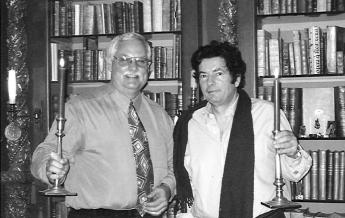

Part 16: Our Greek Friend, continued
Our relationship with Staikos grew exponentially as we got to know and trust each other. John was a comrade to Kostas in their mutual love of the history of the growth of language, and they went to a number of conferences and archeological sites together. I decided to visit him in Athens while on one of my European trips and scheduled a flight from London to Athens in March of 2003 to spend time with him. As many of you probably remember, that is exactly when the Iraq War began and the Greeks were not in favor of what the US had done. Kostas picked me up at the airport and a normal 40 minute drive took over three hours because the entire city of Athens was rallying against the war. My arrival day was especially interesting as Millie and I had donated a large collection of books to the Bibliotheca Alexandrina in Egypt and the Egyptian Embassy in Athens had planned a large reception in our honor that evening. Kostas and I got to the hotel and I barely had time to change into better clothes for the reception which was luckily across the street from my hotel at the Embassy. I was awarded a very large medal by the Greek supporters of this library at the reception and the Egyptian ambassador was the picture of charm and culture in what had to be an awkward situation.
Kostas was the perfect host and showed me the city as it was my first trip to Athens. I was invited to his home for dinner that night which again proved a bit strange as he lives right next to the President of the Greek Republic and soldiers were everywhere as I attempted to get there for the dinner date. After a number of checks I was pointed to the correct building where I was warmly welcomed by Kostas and his sister. I was shown parts of his personal collection which were soul-stirring to an antiquarian bookseller. When it was time for dinner, Kostas pointed me to a chair and commanded that I sit there. Not aware of the social etiquette of the Greek dining experience, I sat as instructed and had a glass of wine as booksellers are known to do. Kostas, with that impish smile I have grown to enjoy so much, then quickly opened the curtains in front of me and there, under floodlights, was the Acropolis. I was stunned with the magnificent view.
My next visit to Kostas was immediately after a Prague Committee meeting of the ILAB in 2007 when Millie and I flew to visit him. We did some serious work on publishing projects while Millie toured the city. His charm was apparent and showed Greek hosting expertise with great aplomb. It was Millie’s birthday and he planned a very nice birthday dinner at one of his favorite restaurants. Our relationship with this man continues to grow as we utilize his letterpress shop to print books for our publishing program and publish new titles that he writes for us.
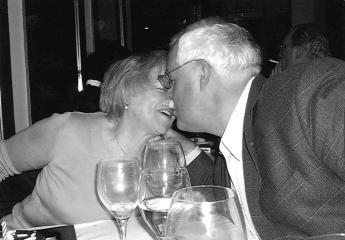
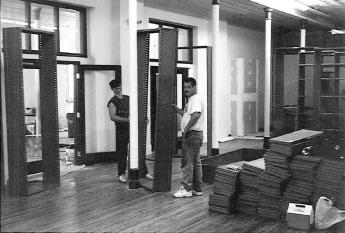
Part 17: Expanding yet again!
The always present problem of lack of space reared its ugly head yet again in 2001—we had run out of room in spite of our expanded 5000 square foot third floor lease. This is such a sickness with booksellers. They can never be happy with the space they have and must keep expanding. John published 21 titles in 2001, and we had bought a large antiquarian collection, so space was at a premium. We decided to lease half the first floor of our building and move our publishing fulfillment and shipping to that floor and even pretend to have a real bookstore presence. We moved in and John found a huge assortment of blue metal shelving being sold at a very good price by a warehouse. We bought the shelving and installed it on the first floor. These bookcases were handy in keeping a small number of each publishing/distribution title arranged by stock number and readily available for order fulfillment. Most of the inventory was kept in a large warehouse in the Newark, Delaware, area as New Castle is not very truck friendly, and we had no docking area at our Delaware Street location. New Castle is a charming city but doesn’t have much in the way of retail street traffic, so street sales didn’t increase much. However, the rent was very reasonable, and we had a lot more space.
Meanwhile my “other job” became closer to a full-time position as I was elected President of ILAB during the Scandinavian Congress of 2002. Millie and I have been to many Congresses, but this whirlwind trip through Sweden, Finland, Norway, and Denmark was one of the best.
John managed to get out another 21 titles in 2002 and followed up with 21 more in 2003, 21 in 2004 and 18 in 2005. I must admit that I did not have as much time to give him as I had before taking on the Presidency of ILAB, but he was becoming an old hand at our type of publishing.
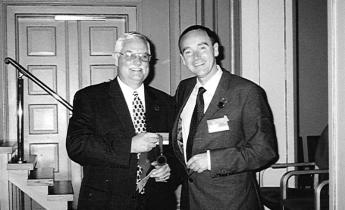
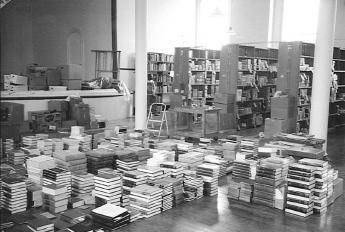
And of course, the strangest thing happened—we ran out of space again in 2005. The antique mall and tea shop had left the second floor, leaving it as empty space. I really didn’t need to be on the first floor, so I discussed the idea of leasing the entire building from the owner and taking on the responsibility for one monthly rental payment for the entire building. I would need to find appropriate sub-leases for the first floor to partially defray my costs. He agreed, and John yet again got a major task—find renters for the first floor, and move our operation from our half of the first floor to the second floor, thus adding 2500 square feet to our space. If we worked it right, we could significantly increase our space and reduce costs by sub-leasing the entire first floor, while moving books out of the Newark warehouse to further reduce our overhead. As usual, John accomplished this task in record time, and now our inventory shares the second floor with Annie Oakley’s ghost.
The Final Chapter of Books about Books: New beginnings for Oak Knoll
In early 2006, however, John told me that it was time for him to retire. I had known this time would eventually come (though I had been hoping he would work into his 90s!). But when he talked about the books he wanted to write and the travel he wanted to do, it was hard to come up with a convincing argument for postponing retirement. I then had to make yet one more decision. I was going to turn 60 in February of 2007, so perhaps it was time to think about slowing down and eliminating some of the stress in my life. I knew that my stress level could only increase once John had gone, as he was going to be hard to replace. My time at the beach house was so relaxing that I could visualize a lighter work load with more vacation time. I loved reading and collecting (especially in the field of Delaware history). Was this the time to sell the publishing business?
Months went by with different possibilities being discussed on a daily basis. I had a publishing director who wanted to retire and was only hanging on to keep me from being without a competent person to run that part of the business. It occurred to me that I had a smart young man named Mark Parker Miller working for me as a book cataloguer in the antiquarian side of the business, and that he might have the makings of a publisher. Mark had finished the course work for his PhD in art history and was in the process of writing his thesis. I had very good experiences in hiring art history graduates from Delaware (Andy Armacost being the prime example). I asked John if he would take a month to train Mark, and he gleefully agreed, finally seeing the beginning of his retirement on the horizon. The training took place in the spring of 2006 and Mark is now going full throttle with 24 books under his belt (with John’s help) in 2006, 16 in 2007 and 21 to-date in 2008.
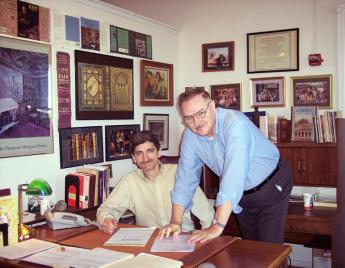
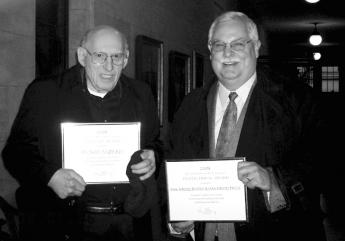
A great help was the addition of Laura Williams in early 2007 as our Marketing Communications Specialist. Her skills at electronic marketing and PR have had a major impact on sales. [Update to 2010: Mark Parker Miller left Oak Knoll at the end of 2008, and Laura Williams has been enjoying her new role as publishing director for the past two years.]
So here we are in the year 2008 after 30 years of publishing in a very specialized field. The publishing world has changed a lot since I first started and will continue to re-invent itself in the future at an ever quickening pace. University presses are being told to make a profit for their universities, as the prestige of having a press is being diminished by hard financial times. As a result, more manuscripts are being offered to us. Oak Knoll has published books with CDs in the back and links to online databases, unknown technologies when we started. Short print runs and print-on-demand seem to be here to stay. Bibliography as a subject begs to be available online, as any good bibliography is always a work in progress. Where will this lead us?
Our marketing strategies have also changed. In the old days we bombarded our customers with letters - now we do it with email programs like Constant Contact. Our weekly strategy meetings are often more about the timing and extent of our email campaigns and an analysis of our Google statistics for the past week than planning the production of a book.
So how do I feel about our role for the next 30 years? Early this year [2008] Oak Knoll Press was given the Institutional Award by the American Printing History Association in recognition of its services in publishing books that advance the understanding of printing history. When accepting this award, I reminisced about Oak Knoll’s past much like I have done in this short history and ended up telling a story of a recent sales call with a relatively new employee. The gist of that story was that the new employee was my youngest son Rob, who had graduated from college and was now working in the business. My other three children (Jenni, Paul, and Wendy) have each chosen other careers outside the book world. Oak Knoll may not end up being Rob’s life work, but for now - it is great to have him with me. Either way, I hope he will enjoy all of the fun, travel, and friendships that I have had for these first 30 years.

Bob Fleck founded Oak Knoll Books in 1976 to fill a void in the booksellers world. Today Oak Knoll Books maintains an inventory of about 20,00 titles on book about books and a rapidly growing backlist of over 950 titles published and distributed under its imprint, Oak Knoll Press. Bob Fleck is ILAB President of Honour. He was ILAB President from 2002 to 2006.
All 18 parts of Bob Fleck’s “History of Oak Knoll Press” are excerpts from his autobiography “Books about Books“ (2008). They are published in The Oak Knoll Biblio Blog, and on ILAB.org. Thank you very much to Bob Fleck for giving us permission.
>>> The Oak Knoll Biblio-Blog
>>> Oak Knoll Books / Oak Knoll Press
>>> Robert D. Fleck, Books about Books. A History and Bibliography of Oak Knoll Press 1978-2008
>>> More about Bob Fleck on ILAB.org
>>> Barbara Kaye Muir about the early days of the League, Excerpts from "Second Impression"
